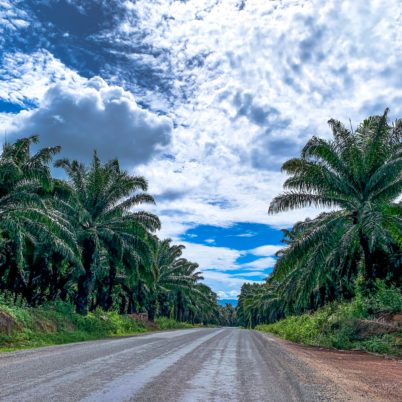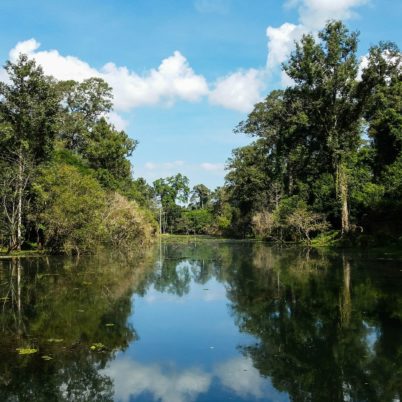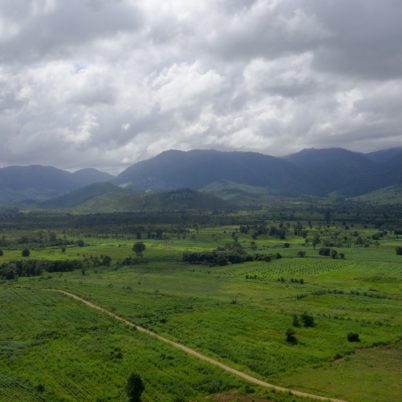Food in Cambodia
A blend of regional, traditional and historical influences have gone into shaping present-day food in Cambodia. This makes it one of the most interesting culinary experiences in south-east Asia. The staples of rice and fish are present in almost every meal.
And yet, the dishes contain unique and interesting bursts of flavour. From fish and chicken, to spiders and crickets, it attracts everyone. Every last aspect has an intriguing story behind it. In Cambodia, there’s a dish in store for everyone, the staid and the adventurous alike. Read on to get a brief overview of food in Cambodia.
Look at a Two Week Cambodia and an One Week Cambodia itinerary
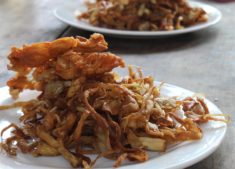 Street food in Siem Reap, an exciting edge to the cycling tour in Siem Reap.
Street food in Siem Reap, an exciting edge to the cycling tour in Siem Reap.
Staples & Traditions of cambodian food
In a country with a dry season of seven months, water plays an extremely important role. This is not just for food supply, but also the availability of ingredients. The Tonle Sap Lake is the biggest freshwater lake in Southeast Asia. It is the main source of water and fish for Cambodians. As soon as the rains start the wet season, rice paddies emerge everywhere and the lake increases dramatically in size. Due to this, rice and freshwater fish are two staples of Cambodian cuisine.
Cambodians serve rice alongside a range of dishes, each with ingredients that give it a certain flavour. Typically, you get served a bowl of rice with which you can mix a range of dishes. These are either sweet, sour or salty, making for interesting meals. Multiple sauces and pickles are served on the side for everyone to choose how to enhance their personal meal.
You will also often spot fried rice and crispy fried noodles, but more in local street-food than as components of a home-cooked meal. Cambodians serve fish in a variety of ways, whether cooked, dried, processed into Prahok (a crushed, salted and fermented paste used for seasoning), or steamed using the famous technique of Amok (the process of steam-cooking curry in banana leaves).
Cambodia is a great value for money destination, read on the understand the cost of travel
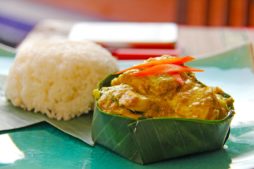 Fish amok – a staple food in Cambodi. Steamed rice along with a fish preparation iserved in banana leaves.
Fish amok – a staple food in Cambodi. Steamed rice along with a fish preparation iserved in banana leaves.
Popular dishes of Cambodian cuisine
One of the most famous dishes to try among travellers in Cambodia is Fish Amok. A slightly sweet curry with subtle hints of lemongrass and kaffir lime, it is always presented in a banana leaf bowl. It has more of a custard consistency thanks to the signature process of steaming during preparation. You can easily find it on menus across the country.
Equally popular are the noodle soups like kuyteav, and dishes cooked in clay pots. And for an experience as unique as possible, try the various street snacks unique to food in Cambodia. These include Banh Chev (a taco-like savoury crepe stuffed with vegetables and meat), the delicacy of Babar or Bor Bor (a rice porridge usually coupled with different kinds of meat), Deep Fried Bananas, and Phlea Sait Kow (a beef-vegetable salad flavoured with local Cambodian spices).
Look at our Vietnam Cambodia Itinerary here
 Kuy teav is a Cambodian noodle soup served with rice noodle, pork stock and toppings of ones choice. From meat balls to boiled eggs.
Kuy teav is a Cambodian noodle soup served with rice noodle, pork stock and toppings of ones choice. From meat balls to boiled eggs.
Additional Tips for sampling Cambodian Cuisine
For a break from the meats, try the salads, made from ingredients like raw mango, papaya and banana blossom. And for a break from the conventional, try the fried spiders and crickets; yes you read that right, we’ll get to it later. Make sure you try the street food. Cooked in front of you and served hot, it kills off any bacteria and is tasty and safe.
The Cambodians are inveterate snackers like many Southeast Asians. As a result, street food is a crucial aspect of daily life and a big part of experiencing food in Cambodia. We recommend you be open to the experience. You’ll also find popular meats like that of duck and chicken in Cambodia, often paired with fish. Pork and beef are also available, but the Cambodians consider them rare treats due to their high price.
If you have a sweet tooth, which we definitely do, make sure you try the irresistible ice-cream sandwich at the local night markets. And finally, make sure you sample the range of fruits this region is blessed with. The most popular of these is Mongkut (Mango-steen) and Sao Mao (Rambutan). The small mangosteen has a purple skin containing white segments with flavours that leave you craving for more. The rambutan, covered in soft red and green spikes, resembles lychee on the inside. Cambodia is home to many tropical fruits and sampling these is an integral part of a visit to the country. Other common fruits found in abundance include chek (banana), menoa (pineapple) and duong (coconut).
 Mangosteen, one bite of this exotic fruit is just not enough. Try it and it’s all you’ll be craving during you time in Cambodia.
Mangosteen, one bite of this exotic fruit is just not enough. Try it and it’s all you’ll be craving during you time in Cambodia.
A glimpse of history with every bite – Neighbouring and Colonial influences
“Cambodia” is the English version of Kampuchea, the official name of the country. “Khmer” (pronounced kuh-meh) is the name the people call themselves by. Due to this, Cambodian cuisine is often referred to as Khmer cuisine. Cambodian cuisine is a combination of other Southeast Asian and colonial cuisines, with evident traces of influence from historical events in the country’s past. Khmer cuisine shares a lot of characteristics with Thai and Vietnamese cuisines.
This is because both powers have constantly invaded the country over the last few centuries. The French and Chinese invaded both Vietnam and Cambodia, giving them a shared colonial past. As a result, you’ll notice similar French and Chinese culinary influences in the form of rice noodles and the baguette. You’ll also spot Indian influences in the form of curries, known as Kari in Cambodia. The wide use of peanuts on the other hand, is a Portuguese influence.
Despite these numerous influences, authentic Cambodian cuisine retains its uniqueness. This is in the form of limited use of spices and coconut cream, and the addition of several local spices like coriander, mint and lemongrass. Kroeung, a distinctive spice paste made with a base of lemongrass and galangal, is the foundation of many Cambodian dishes. Cambodian cuisine bears perhaps the most foreign influences than any other cuisine in the world. Despite that, it still retains its own identity, and has a delicious glimpse of history in every bite, leaving you craving for more.
Fill this form and let us plan your Cambodia adventure!
 The French baguette was turned into a local Cambodian street food dish called Num Pang. Usually packed with meat (mostly pork) and some salad.
The French baguette was turned into a local Cambodian street food dish called Num Pang. Usually packed with meat (mostly pork) and some salad.
The creepy crawlies of Cambodian cuisine
Tourists often find certain aspects of Cambodian cuisine strange, or even gruesome, due to their consumption of creatures like tarantulas, crickets, ants, scorpions, algae, fish bladders and frogs. This tradition arises from the country’s tragic times during the Civil War and the brutal oppression during the Khmer Rouge period of the 70’s. Locals were forced into the countryside, and at a time of rampant starvation, were compelled to eat these foods as they were rich sources of protein. Today, it is a popular custom and a major part of Cambodian cuisine. Tarantulas, seasoned and stir fried, are sold as snacks. You will find the red ant beef salad at restaurants throughout the country. Their deep-rooted history and tragic past play a major role in normalizing these items as part of their local cuisine, and the adventurous can try these with no inhibitions.
You could be worried about adjusting to the local food in Cambodia. In this case, rely on the several restaurants serving international cuisines. They even cater to various diet requirements and have provisions for vegetarians and vegans as well.
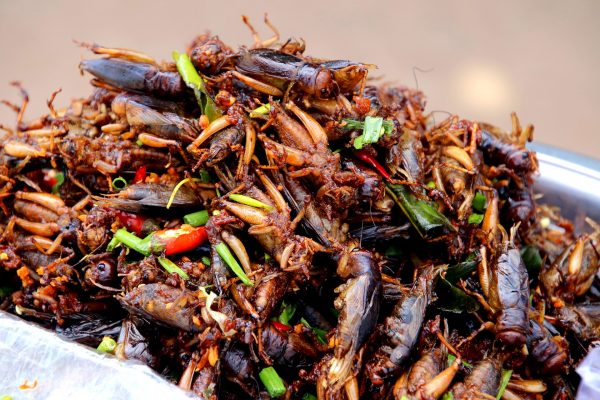 Cockroach salad cooked with chillies and spring onion, a common Cambodian street food delicacy.
Cockroach salad cooked with chillies and spring onion, a common Cambodian street food delicacy.
Present day Cambodian cuisine
A sad aspect of Khmer cuisine is the loss of records of traditional food recipes during the Khmer Rouge oppression. The royal families and elitists were the ones who ate these dishes. However, the main aim of the brutal leader Pol Pot was to destroy any intellectual property to promote a rural way of life. Due to this, he ordered for the destruction of art, literature, science, and these recipe records. Despite this, and the various other influences on its cuisine, Cambodians managed to keep their passion for food and tradition intact. That in itself is a commendable effort that only makes Cambodian cuisine and culture a lot more fascinating.
Travellers seeking an offbeat experience to explore the food in Cambodia can sign up for local cooking classes or exciting food tours available in the two main cities of Siem Reap and Phnom Penh for a better understanding of Cambodian culture and its traditional food. Food in Cambodia is a marvel to explore, so have a look at best places to visit or the cost of travelling to start planning. If you’re a culinary enthusiast, we highly recommend looking at our take on Vietnamese and Thai cuisine as well. We can guarantee the next thing on your mind will be an Indochina trip that we can help you plan.
helping you travel your way
We provide a helping hand to independent travellers who need assistance with planning and booking their trip. The primary goal is to turn your dream holiday into reality.

